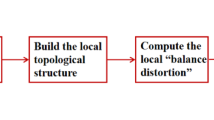Abstract
In this paper, we present an evaluation strategy based on human-generated ground truth to measure the performance of 3D interest point detection techniques. We provide quantitative evaluation measures that relate automatically detected interest points to human-marked points, which were collected through a web-based application. We give visual demonstrations and a discussion on the results of the subjective experiments. We use a voting-based method to construct ground truth for 3D models and propose three evaluation measures, namely False Positive and False Negative Errors, and Weighted Miss Error to compare interest point detection algorithms.











Similar content being viewed by others
References
Boyer, E., Bronstein, A.M., Bronstein, M.M., Bustos, B., Darom, T., Horaud, R., Hotz, I., Keller, Y., Keustermans, J., Kovnatsky, A., Litman, R., Reininghaus, J., Sipiran, I., Smeets, D., Suetens, P., Vandermeulen, D., Zaharescu, A., Zobel, V.: SHREC 2011: robust feature detection and description benchmark. In: 3DOR, pp. 71–78 (2011)
Bronstein, A., Bronstein, M., Bustos, B., Castellani, U., Crisani, M., Falcidieno, B., Guibas, L., Kokkinos, I., Murino, V., Sipiran, I., Ovsjanikovy, M., Patanè, G., Spagnuolo, M., Sun, J.: SHREC 2010: robust feature detection and description benchmark. In: Eurographics Workshop on 3D Object Retrieval (3DOR’10), pp. 79–86 (2010)
Castellani, U., Cristani, M., Fantoni, S., Murino, V.: Sparse points matching by combining 3D mesh saliency with statistical descriptors. Comput. Graph. Forum 27(2), 643–652 (2008)
Chung, M., Taylor, J.: Diffusion smoothing on brain surface via finite element method. In: ISBI, pp. 432–435 (2004)
Dutagaci, H., Cheung, C.P., Godil, A.: Evaluation of 3D interest point detection techniques. In: 3DOR, pp. 57–64 (2011)
Gelfand, N., Mitra, N.J., Guibas, L.J., Pottmann, H.: Robust global registration. In: Symposium on Geometry Processing, pp. 197–206 (2005)
Godil, A., Wagan, A.I.: Salient local 3D features for 3D shape retrieval. In: 3D Image Processing (3DIP) and Applications II. SPIE, Bellingham (2011)
Harris, C., Stephens, M.: A combined corner and edge detector. In: 4th Alvey Vision Conference, pp. 147–151 (1988)
Hu, J., Hua, J.: Salient spectral geometric features for shape matching and retrieval. Vis. Comput. 25(5–7), 667–675 (2009)
Kim, Y., Varshney, A., Jacobs, D.W., Guimbretière, F.: Mesh saliency and human eye fixations. ACM Trans. Appl. Percept. 7(2), 12 (2010)
Lee, C.H., Varshney, A., Jacobs, D.W.: Mesh saliency. In: ACM SIGGRAPH 2005, pp. 659–666 (2005)
Litman, R., Bronstein, A.M., Bronstein, M.M.: Diffusion-geometric maximally stable component detection in deformable shapes. Comput. Graph. 35(3), 549–560 (2011)
Lloyd, B.A., Szekely, G., Kikinis, R., Warfield, S.K.: Comparison of salient point detection methods for 3D medical images. The Insight Journal—2005 MICCAI Open-Source Workshop (2005)
Lowe, D.G.: Distinctive image features from scale-invariant keypoints. Int. J. Comput. Vis. 60(2), 91–110 (2004)
Maes, C., Fabry, T., Keustermans, J., Smeets, D., Suetens, P., Vandermeulen, D.: Feature detection on 3d face surfaces for pose normalisation and recognition. In: Biometrics Theory Applications and Systems BTAS 2010 Fourth IEEE International Conference on, pp. 1–6 (2010)
Mian, A., Bennamoun, M., Owens, R.: On the repeatability and quality of keypoints for local feature-based 3D object retrieval from cluttered scenes. Int. J. Comput. Vis. 89(2–3), 348–361 (2010)
Novatnack, J., Nishino, K.: Scale-dependent 3D geometric features. In: ICCV, pp. 1–8 (2007)
Sebe, N., Lew, M.S.: Comparing salient point detectors. Pattern Recognit. Lett. 24(1–3), 89–96 (2003)
Sipiran, I., Bustos, B.: A robust 3D interest points detector based on Harris operator. In: Eurographics 2010 Workshop on 3D Object Retrieval (3DOR’10), pp. 7–14 (2010)
Sipiran, I., Bustos, B.: Harris 3D: a robust extension of the Harris operator for interest point detection on 3D meshes. Vis. Comput. 27, 963–976 (2011)
Smith, S.M., Brady, J.M.: Susan—a new approach to low level image processing. Int. J. Comput. Vis. 23, 45–78 (1995)
Sun, J., Ovsjanikov, M., Guibas, L.: A concise and provably informative multi-scale signature based on heat diffusion. In: Eurographics Symposium on Geometry Processing (SGP), pp. 1383–1392 (2009)
Walter, N., Aubreton, O., Laligant, O.: Salient point characterization for low resolution meshes. In: ICIP, pp. 1512–1515 (2008)
Wessel, R., Novotni, M., Klein, R.: Correspondences between salient points on 3D shapes. In: Vision, Modeling, and Visualization (VMV’06), pp. 365–372 (2006)
Zaharescu, A., Boyer, E., Varanasi, K., Horaud, R.P.: Surface feature detection and description with applications to mesh matching. In: CVPR (2009)
Zou, G., Hua, J., Dong, M., Qin, H.: Surface matching with salient keypoints in geodesic scale space. Comput. Animat. Virtual Worlds 19(3–4), 399–410 (2008)
http://www.itl.nist.gov/iad/vug/sharp/benchmark/3DInterestPoint/
Acknowledgements
We would like to thank Daniela Giorgi and AIM@SHAPE for the models from the Watertight Track of SHREC 2007, and Stanford Computer Graphics Laboratory for the models from The Stanford 3D Scanning Repository. We would like to thank Ivan Sipiran, Benjamin Bustos, Umberto Castellani, Ko Nishino, and Prabin Bariya for sharing their interest point detection codes.
Author information
Authors and Affiliations
Corresponding author
Rights and permissions
About this article
Cite this article
Dutagaci, H., Cheung, C.P. & Godil, A. Evaluation of 3D interest point detection techniques via human-generated ground truth. Vis Comput 28, 901–917 (2012). https://doi.org/10.1007/s00371-012-0746-4
Published:
Issue Date:
DOI: https://doi.org/10.1007/s00371-012-0746-4




